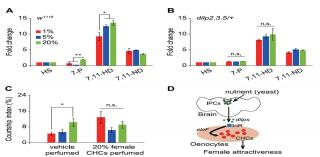Feb, 2018

Appropriate sexual selection or individual sexual attractiveness is closely associated with the reproductive success of a species. Here, we report that young male flies exhibit innate courtship preference for female flies that are raised on higher‐yeast diets and that have greater body weight and fecundity, but reduced locomotor activity and shortened lifespan. Male flies discriminate among females that have been fed diets that contain 3 different yeast concentrations—1, 5, and 20% yeast—via gustatory, but not visual or olfactory, perception. Female flies that are raised on higher‐yeast diets exhibit elevated expression levels of Drosophila insulin‐like peptides (dilps), and we demonstrate that hypomorphic mutations of dilp2, 3, 5 or foxo, as well as oenocyte‐specific gene disruption of the insulin receptor, all abolish this male courtship preference for high yeast‐fed females. Moreover, our data demonstrate that disrupted dilp signaling can alter the expression profile of some cuticular hydrocarbons (CHCs) in female flies, and that genetic inhibition of an enzyme involved in the biosynthesis of CHCs in oenocytes, elongase F, also eliminates the male courtship preference. Together, our findings provide mechanistic insights that link female reproductive potential to sexual attractiveness, thereby encouraging adaptive mating and optimal reproductive success.